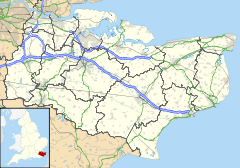Chalk, Kent
| Chalk | |
|---|---|
| Chalk shown within Kent | |
| Population | 2,163 (2011.Ward) |
| OS grid reference | TQ675735 |
| District | |
| Shire county | |
| Region | |
| Country | England |
| Sovereign state | United Kingdom |
| Post town | GRAVESEND |
| Postcode district | DA12 |
| Dialling code | 01474 |
| Police | Kent |
| Fire | Kent |
| Ambulance | South East Coast |
| EU Parliament | South East England |
Chalk is chiefly a suburb but also a civil parish which adjoins the east of Gravesend, Kent, England. As is intuitive, its name comes from the Saxon word cealc meaning a chalkstone.
One layer of the chalk carries flints, stones embedded in the chalk, and these were used in building and in providing the means of fire for muskets. The stone is often cut to provide a flat edge as a craft known as flint-knapping. The trade was worked in Chalk from the 17th century onwards. Gun-flints were produced here in large quantities until the early 19th century.
Current issues relating to the immediate environment around Chalk include a proposed new Lower Thames Crossing through Shorne Wood Country Park and across the estuary marshes at Chalk, confirmed in 2017, and a mooted new Thames Estuary Airport resulting in low-flying aircraft over the village from the Isle of Grain.
Chalk, already known in the 8th century from a witan (a Saxon meeting) held here, is mentioned in the Domesday Book. A large Roman villa was discovered here in 1961. Of the farms in the parish, Filborough is the oldest, having historical mention as early as AD 1220. At one time it was owned by Henry VIII. Two of its manor houses were called West Court and East Court.
Chalk's major claim to fame is its connection with Charles Dickens. Here he spent his honeymoon with his new bride, Catherine Hogarth; and it was here that he wrote the early instalments of Pickwick Papers. He also used the old forge in the village as a model for Joe Gargery's cottage in Great Expectations. The building still stands as a historically listed building .
...
Wikipedia

